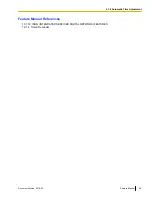
Calls that are exempt from ARS are connected to the user-selected line, via the default carrier for that line.
[Programming Example: ARS Leading Number Exception Table]
Location
No.
1
2
3
Leading No.
Exception
*1
555
556
567
*1
®
16.6 PBX Configuration—[8-6] ARS—Leading Number Exception
In this example:
555, 556, and 567 are local exchanges. (555-XXXX, 556-XXXX, 567-XXXX)
These calls can be made using any carrier, and are therefore exempt from ARS.
3.
Leading Number Table
Next, store the leading numbers of telephone numbers that should be routed by ARS, and assign a Routing
Plan to each leading number that will control how calls containing these leading numbers are routed.
When an extension user dials a number which contains a leading number stored in the ARS Leading
Number Table, the call will be routed the corresponding Routing Plan assigned here. Note that the CO
Line Access number is always ignored by ARS and does not need to be programmed here.
Before programming the details of each Routing Plan (explained below), you can simply assign here the
same Routing Plan number to all the different leading numbers which will be routed the same way.
If a dialed number matches two or more leading numbers stored in the ARS Leading Number Table, the
lowest numbered location will have priority.
[Programming Example: ARS Leading Number Table]
Location
No.
1
2
3
Leading
No.
*1
1212
01181
01144
Routing Plan
No.
*3
1
5
12
Additional
No. of Digits
*2
7
0
0
*1
®
16.2 PBX Configuration—[8-2] ARS—Leading Number—
*2
®
16.2 PBX Configuration—[8-2] ARS—Leading Number—
*3
®
16.2 PBX Configuration—[8-2] ARS—Leading Number—
Additional Number of Digits
In order for calls to be made using the desired carrier, telephone numbers dialed by extension users must
be modified to meet the criteria required by the carrier. (Refer to 5. Carrier Table.) This modification usually
involves removing digits and adding access codes to the beginning of the dialed number.
In situations where a preprogrammed number (such as an Itemized Billing Code) must be added
automatically after the telephone number that was dialed by the extension user, set the Additional Number
of Digits to a value greater than 0.
4.
Routing Plan
Since the preferred carrier may vary depending on the time of day, you can create an ARS-specific time
table and break each day of the week into different time blocks. A different carrier can then be assigned
to each time block.
Routing Plan Time Table:
For each Routing Plan, a different carrier can be assigned for each time of day
and each day of the week. Each day can have up to four programmable time blocks.
24
Feature Manual
Document Version 2016-03
2.1.3 ARS (Automatic Route Selection)
Summary of Contents for KX-NS1000
Page 15: ...Section 1 For Your Safety Document Version 2016 03 Feature Manual 15...
Page 18: ...18 Feature Manual Document Version 2016 03 1 1 1 For Your Safety...
Page 19: ...Section 2 Features and Configurations A Document Version 2016 03 Feature Manual 19...
Page 36: ...36 Feature Manual Document Version 2016 03 2 1 8 Automatic Time Adjustment...
Page 37: ...Section 3 Features and Configurations B Document Version 2016 03 Feature Manual 37...
Page 44: ...44 Feature Manual Document Version 2016 03 3 1 2 BGM Background Music...
Page 45: ...Section 4 Features and Configurations C Document Version 2016 03 Feature Manual 45...
Page 89: ...Section 5 Features and Configurations D Document Version 2016 03 Feature Manual 89...
Page 122: ...122 Feature Manual Document Version 2016 03 5 1 18 DSP Resource Usage...
Page 123: ...Section 6 Features and Configurations E Document Version 2016 03 Feature Manual 123...
Page 137: ...Section 7 Features and Configurations F Document Version 2016 03 Feature Manual 137...
Page 159: ...Section 8 Features and Configurations G Document Version 2016 03 Feature Manual 159...
Page 165: ...Section 9 Features and Configurations H Document Version 2016 03 Feature Manual 165...
Page 172: ...172 Feature Manual Document Version 2016 03 9 1 6 Hot Line...
Page 173: ...Section 10 Features and Configurations I Document Version 2016 03 Feature Manual 173...
Page 217: ...Section 11 Features and Configurations K Document Version 2016 03 Feature Manual 217...
Page 220: ...220 Feature Manual Document Version 2016 03 11 1 1 KX UT Series SIP Phones...
Page 221: ...Section 12 Features and Configurations L Document Version 2016 03 Feature Manual 221...
Page 228: ...228 Feature Manual Document Version 2016 03 12 1 4 Local Alarm Information...
Page 229: ...Section 13 Features and Configurations M Document Version 2016 03 Feature Manual 229...
Page 237: ...Section 14 Features and Configurations O Document Version 2016 03 Feature Manual 237...
Page 252: ...252 Feature Manual Document Version 2016 03 14 1 9 Operator Features...
Page 253: ...Section 15 Features and Configurations P Document Version 2016 03 Feature Manual 253...
Page 331: ...Section 16 Features and Configurations Q Document Version 2016 03 Feature Manual 331...
Page 333: ...Section 17 Features and Configurations R Document Version 2016 03 Feature Manual 333...
Page 340: ...340 Feature Manual Document Version 2016 03 17 1 3 Room Status Control...
Page 341: ...Section 18 Features and Configurations S Document Version 2016 03 Feature Manual 341...
Page 364: ...364 Feature Manual Document Version 2016 03 18 1 12 Syslog Record Management...
Page 365: ...Section 19 Features and Configurations T Document Version 2016 03 Feature Manual 365...
Page 385: ...Section 20 Features and Configurations U Document Version 2016 03 Feature Manual 385...
Page 443: ...Section 21 Features and Configurations V Document Version 2016 03 Feature Manual 443...
Page 448: ...448 Feature Manual Document Version 2016 03 21 1 2 Virtual PS...
Page 449: ...Section 22 Features and Configurations W Document Version 2016 03 Feature Manual 449...
Page 459: ...Section 23 Appendix Document Version 2016 03 Feature Manual 459...
Page 481: ...Document Version 2016 03 Feature Manual 481 Notes...

































